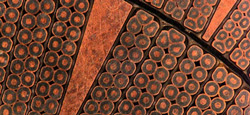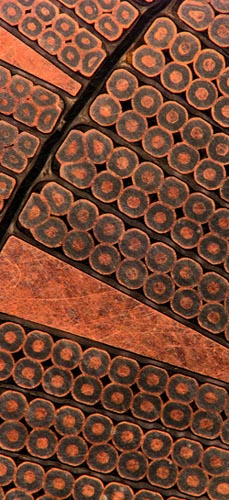Magnetic Protection
Superconductors and magnets don’t get along. A strong enough magnetic field destroys superconductivity by disrupting the precisely coordinated motion of electrons that allows a current to flow without resistance. In the 31 March PRL, researchers describe how the addition of a gold nanolayer to a thin superconducting film allows the material to sustain higher magnetic fields before failing. The results may offer clues toward designing superconducting wires better able to operate in the presence of magnetic fields, such as those used in MRI magnets and particle accelerators. Further studies of the effect may also improve researchers’ understanding of the electron pairing that is at the heart of superconductivity.
In a superconductor, current is carried by so-called Cooper pairs of electrons. Typically, the paired electrons have opposite spin and opposite momentum–at any moment in time, one could be spin-up, moving left, the other spin-down, moving right. A magnetic field exerts forces that try to unbalance the electrons’ momentum and also align both spins with the field direction. But because it takes a certain amount of energy to disrupt the Cooper pairs, a superconductor can tolerate magnetism up to a point before reverting to a normally conducting state.
Phil Adams and his colleagues at Louisiana State University in Baton Rouge built 2- to 30-nanometer-thick layers of beryllium, a superconductor, on a glass substrate, then deposited a half-nanometer gold film on top. The researchers found that the gold-coated beryllium films, when placed in a magnetic field aligned parallel to the layers, remained superconducting in fields far stronger than beryllium alone could withstand. For the thinnest film, just two nanometers thick, the critical magnetic field increased by ten times.
Physicists have known for some decades that a variety of “proximity effects” arise at an interface between a superconducting and a non-superconducting material, because Cooper pairs can leak into the normal material a little way, while the normal atoms exert an influence into the superconductor. In this case, Adams and his coauthors say, the crucial ingredient is an interaction between the electron spins and the large positive charges of the gold nuclei.
Because the electrons and the nuclei are moving relative to each other, each charge experiences the other as a current, and currents generate magnetic fields. The field the electrons feel coming from the gold nuclei–which is much larger than that of the smaller beryllium nuclei–nudges the electron spins in each Cooper pair away from exactly opposite alignment. These distorted pairs are better able to accommodate an external magnetic field because their reoriented spins are closer to what the magnetic field prefers. But if the field isn’t parallel to the layers, it turns out that it can destroy superconductivity by interfering with the momentum balance of the pairs, rather than disrupting the spins.
Though practical applications are a long way off, Adams sees potential for designing superconducting wires in the form of multilayered sandwiches. Coils of these wires might reach stronger fields than those of today’s superconducting magnets, which are used in MRI machines and physics research. The possibility of tweaking a superconductor’s properties through control of its microstructure is a “hot topic,” agrees Venkat Chandrasekhar of Northwestern University in Evanston, Illinois. The novel effect Adams and his colleagues have demonstrated, he adds, may help researchers studying the Cooper pairings of the high-temperature ceramic superconductors, whose superconductivity is still not fully understood.
–David Lindley
David Lindley is a freelance science writer, now retired. His most recent book is The Dream Universe: How Fundamental Physics Lost Its Way (Penguin Random House, 2020).





